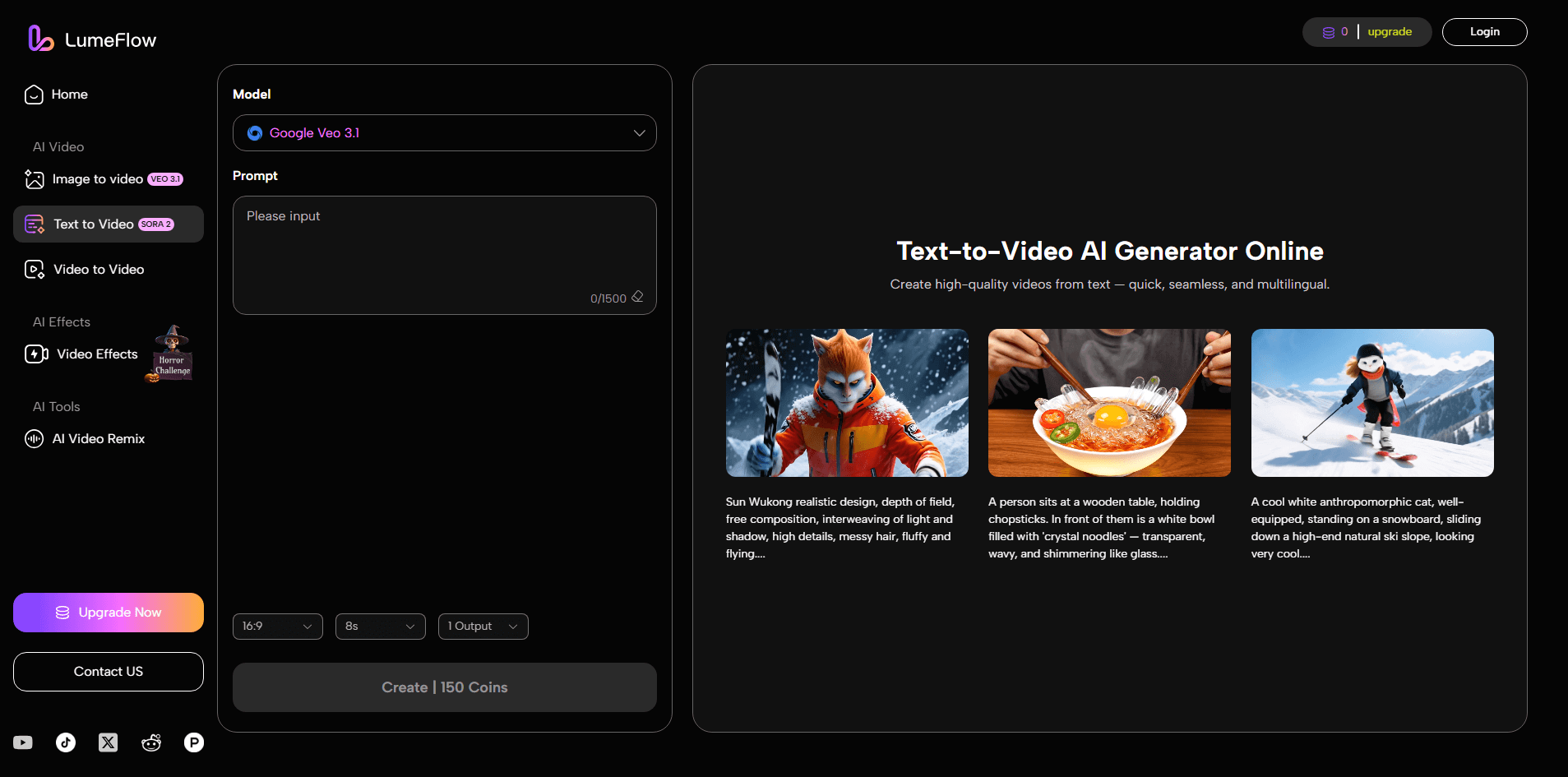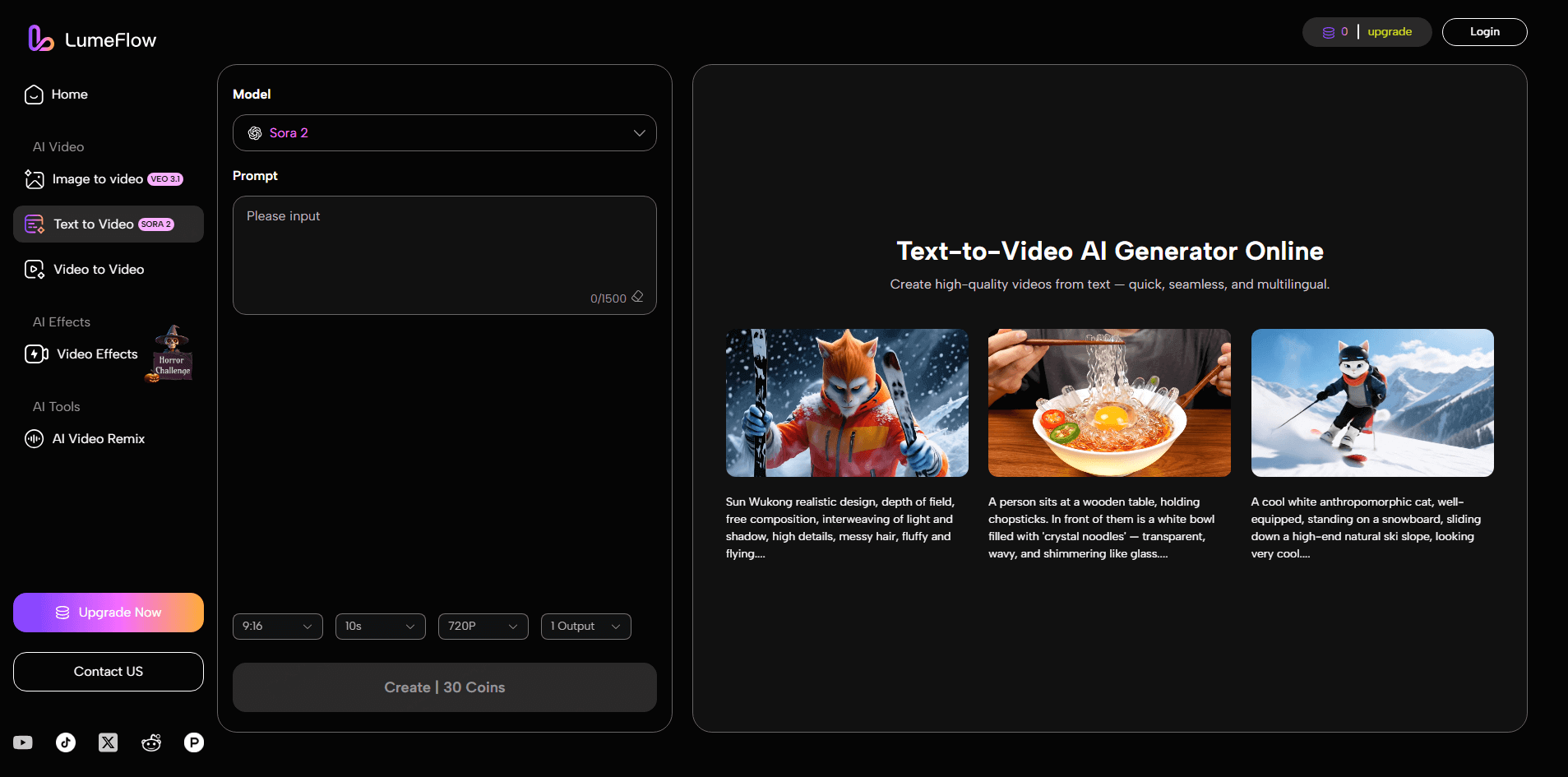In the rapidly evolving world of AI-driven creativity, the difference between a bland clip and a cinematic masterpiece often comes down to just a few words. Whether you're a content creator, marketer, or filmmaker, knowing how to craft prompts for movie quality generative video is your secret superpower. Let's dive in.
What Is a Prompt for AI Video Generation?
When working with text-to-video tools, a prompt is simply the instruction or description you provide, so the AI knows what to generate. For example, you might write a prompt like: "Wide aerial shot of a futuristic city at dusk, gliding over skyscrapers, with warm orange light and faint humming drone sounds."
Different roles and their prompt styles:
🎞️ Storyteller / Filmmaker: "A dramatic low-angle tracking shot through a dense forest at twilight, mist swirling, a lone wolf howling in the distance, cinematic film-look, 24 fps."
📣 Marketer / Brand video creator: "Close-up slow-motion of a ceramic mug being filled with coffee, steam rising, soft golden glow, elegant and minimalist, ambient jazz score."
📱 Social media creator / Short-form video: "Vertical 9:16 format, energetic jump cut montage of city skateboarding at sunset, upbeat electronic music, lens flare transitions."
Understanding what a prompt is and adapting it for your role is the first step toward generating compelling AI videos.
Why Accurate Prompts Are Critical for Video Generation
The prompt is your bridge between your creative intent and the AI model's output. Here's why getting it right matters — or why it fails when you don't.
The consequences of a poor prompt
❌ A vague prompt can lead to generic or irrelevant visuals, e.g., "city at night" might generate something dull or inconsistent.
❌ In video generation, motion consistency, style coherence, and camera logic matter — poor prompts can cause jarring transitions, erratic movement, or unnatural lighting.
The advantages of a well-crafted prompt
✅ You get stronger alignment with your vision — the AI video model knows the aesthetic, mood, and motion you want.
✅ Fewer revisions — better prompts mean fewer rounds of tweaking and faster turnaround.
✅ The results feel professional and cinematic, elevating your output and making your video stand out.
In short: your prompt is not just a description — it is the creative input that dictates style, motion, emotion, and output quality.
How to Craft Basic Prompts That Actually Generate What You Want
Here's a step-by-step framework to write solid basic prompts for video generation. Each step builds upon the last, helping you move from "random clip" to "cinematic storytelling".
STEP1 Start With the Core Subject
Your subject is the foundation. Who or what is in your video?
🎬 Example Prompt:
"A young woman standing on a mountain."
Simple, but it gives AI a starting point.
STEP2 Add Context and Setting
Tell the AI where the action happens and when. Setting provides atmosphere.
🎬 Improved Prompt:
"A young woman standing on a mountain during sunrise, surrounded by golden mist."
STEP3 Define the Mood or Emotion
Mood drives storytelling. Is it hopeful, tense, romantic, mysterious?
🎬 Example:
"A young woman standing on a mountain at sunrise, smiling softly as the wind moves her hair — peaceful and cinematic."
STEP4 Specify Camera Style and Motion
Cinematic quality comes from angles and movement — describe them clearly.
🎬 Example:
"Aerial shot circling around a young woman standing on a mountain at sunrise, cinematic lighting, soft lens flare."
STEP5 Enhance With Style or Theme
Want a Pixar vibe? A noir feel? Tell the AI.
🎬 Final Basic Prompt:
"Aerial cinematic shot of a young woman standing on a mountain at sunrise, glowing mist, lens flare, inspired by Studio Ghibli aesthetics."
Tip
Start simple, then layer detail gradually. Don't overload your prompt all at once.
Common Mistakes to Avoid When Writing Prompts
To get the best results, you'll also want to steer clear of some frequent missteps. Here are common pitfalls and how to fix them.
Mistake 1: Being too vague
✖️ "A city scene"
Fix: Add details — "A sprawling modern cityscape at dusk, aerial drone shot, neon reflections on wet pavement, cinematic mood."
Mistake 2: Over-loading the prompt with too many conflicting instructions
✖️ "A cartoon dog in a realistic war zone, 4K ultra HD, hypnotic slow motion, hand-drawn style, rock concert lighting, HDR 8K, documentary tone."
Fix: Choose a coherent style and focus — e.g., realistic war zone or hand-drawn style, not both.
Mistake 3: Ignoring camera and motion directions
✖️ Without specifying how the shot behaves, the result may feel "floating" or directionless.
Fix: Add "tracking shot", "panning camera", "tilt up", etc.
Mistake 4: Forgetting aspect ratio or frame context
✖️ If you need a vertical mobile clip but write a generic prompt you may get a 16:9 landscape and lose mobile usability.
Fix: Specify "vertical 9:16 format" if needed.
Mistake 5: Too much emphasis on metadata or tech specs
✖️ "Use codec H.265, 60fps, 10 000 × 6000 resolution"
Fix: Most models focus on creative description — you'll get better output by focusing on visual style rather than deep technicals.
By avoiding these mistakes, your prompts become sharper, more effective, and more likely to produce the intended results.
How to Adapt Prompts for Different AI Video Models: Practical Use Cases
Different video generation models have strengths and quirks — tailoring your prompt accordingly will maximise output quality. Below are four popular models and how you might adjust prompts for each.
1 Google Veo 3 – Realistic Cinematic Scenes
Google Veo 3 excels in realism, motion precision, and cinematic rendering. Use film-style language and camera cues.

Prompt focus: Emphasise realism, audio cues, cinematic camera moves.
🎬 Example:
"A slow-motion cinematic tracking shot of a surfer riding a massive blue wave, sunlight filtering through water."
Result: Produces very high realism and integrated audio; ideal for cinematic scenes.
2 Sora 2 – Dynamic Storytelling and Scene Continuity
Sora 2 shines in storytelling and emotional flow. It understands narrative sequence well.

Prompt focus: Emphasise rapid iteration, multiple angles, variation styles.
🎬 Example:
"A child chasing a glowing butterfly through a forest, the camera following smoothly between trees, dreamy soft light."
Result: Ideal when your video involves characters and movement; emphasises dynamic scenes.
3 PixVerse AI – Artistic and Anime-Inspired Worlds
Pixverse AI generates stylized, anime, or fantasy-style visuals. Be descriptive with color, style, and emotion.

Prompt focus: Emphasise style, texture, and creative motion.
🎬 Example:
"Anime-style scene of a boy and a girl standing under cherry blossoms, petals drifting in the wind, vibrant colors, emotional tone."
Result: Great for stylised animations or artistic visuals rather than pure photorealism.
4 Kling AI – Motion Control and Marketing Videos
Kling AI specializes in smooth transitions and brand-friendly visuals — ideal for ad creatives or short reels.

Prompt focus: Emphasise characters, consistent appearance, choreography, camera choreography.
🎬 Example:
"Slow-motion product shot of a perfume bottle rotating gracefully in midair, shimmering reflections, golden backlight, elegant and luxurious aesthetic."
Result: Very useful for marketing, internal videos, fast-paced content where production speed matters.
From Basic to Advanced: Crafting Prompts for Professional Results
After testing different models, you've likely mastered the basics.
Now let's go beyond simple prompts and aim for cinematic storytelling, emotional arcs, and visual rhythm.
STEP1 Define Narrative Flow
Add a beginning, middle, and end.
💬 "A runner starting at dawn, training through the day, finishing at sunset — symbolizing persistence."
STEP2 Include Lighting Transitions
Lighting shifts show emotional change.
💬 "From dark clouds to bright golden sunlight as the runner crosses the finish line."
STEP3 Integrate Camera Dynamics
Use cues like "tracking shot", "slow pan", or "drone zoom-out" to mimic real cinematography.
💬 "Tracking shot from behind, slow pan to reveal the horizon."
STEP4 Refine With Style and Tone
Pick a cinematic tone — gritty realism, dreamlike fantasy, or minimalist elegance.
💬 "Shot in the style of Christopher Nolan with realistic shadows and dynamic depth."
STEP5 Add Symbolism or Emotional Layer
Give meaning to visuals.
💬 "The runner's reflection in puddles mirrors self-doubt — resolved as the sunlight breaks through."
Tip
Create emotion, not just motion. That's what separates professional prompts from amateur ones.
LumeFlow AI: Your Key to Crafting Movie-Quality AI Video Prompts
LumeFlow AI brings together Google Veo 3, Sora 2, Pixverse AI, and Kling AI — all within one intuitive platform.
It's designed for creators who want cinematic, story-rich, and high-quality videos — without complex tools or endless prompt testing.
Why Choose LumeFlow AI
- ★ Access to multiple leading AI models in one place
- ★ Fast generation—videos ready in under a minute
- ★ Built-in prompt optimization tools
- ★ Supports multiple languages and artistic styles
- ★ Affordable pricing for creators and agencies
Final Thoughts
Prompts are the script your AI follows. Mastering them turns your ideas into motion, your imagination into film. Whether you're testing basic structure or crafting advanced storytelling, every cinematic video starts with the right words. And if you want a tool that lets you bring all these strategies to life in one place — LumeFlow AI is your best companion.
Start creating movie-quality AI videos today with LumeFlow AI.








